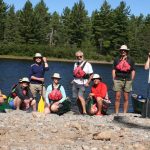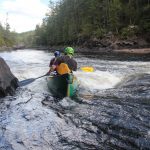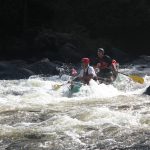CANOEING DOWN THE PETAWAWA RIVER IN ONTARIO CANADA
The Petawawa River in Ontario is one of the rivers that features in Bill Mason’s books and videos , and many of the rapids and falls are used as examples by him of how to read and run white water. The river has been, and still is, under threat from logging and hydroelectric power production, and having the chance to go and paddle in the area it naturally was top of the hit list.
Strangely the journey down the river started in Quebec at the outfitters where we spent a day sorting out equipment and buying food for our stay on the river. The next day we drove to the put-in in Algonquin Park. At the rangers’ office we had to pay park permits and book onto the river but it did give us a chance to buy books and maps of the area.
Although it was the middle of September it was hot work loading the boats and we were glad to get onto the water to cool down. We began our paddle at the foot of the grade 5 Poplar Rapid that run into Travers Lake and we would finish at the take-out on MacManus Lake; the ‘classic route’. We lunched halfway down the lake on a beach of white sand that was hot to the touch, before paddling off down the lake. The scenery was stunning, a mix of pine, birch and maple. Getting ready for winter the maple leaves were turning from green to all the autumn colours of yellow and red. Away from roads and all habitation we were truly in the wild. There was a hot breeze blowing across the lake, wafting pine scent from the forest and as we were now turning to have it on our backs we decided to put up an awning and sail down the lake. We were looking for an easy section down to the nights camp, but once we got the sail up the ‘totally’ wind dropped! Typical.
We spent the night on an island just before the start of the river proper and were treated to a glorious sunset with a jet black night, lit by thousands of stars, with the occasional flash of a shooting star thrown in. A perfect start to the trip.
Travelling down the Petawawa demanded all our river running skills; there were plenty of rapids, graded from 1 to 4, some we could paddle, others we had to line and one we had to portage. The portage was through some tough terrain which was not helped by it coinciding with our only wet afternoon. We were glad to get into camp which was memorable as a damp and smoky evening as the heavens opened. The only time we saw any other paddlers was at the portage and at the finish, other than that we were very lucky to have the river to ourselves, during the summer it would be a lot busier.
The fishing was good, we did eat catfish. Having caught a few and deciding not to eat something so ugly we looked it up in a guide which said that it was good eating; none were set free after that. It has good firm flesh but the skin is tough to cut and it is mainly head.
The best campsite was just below Natch rapids, we had been advised on a two night stop over at the site and we were not disappointed; the views were stunning. There was time to relax to fish, swim, whittle, drink tea and chat. It was here under another black velvet night sky that our thoughts came back to Bill Mason; he will have stopped at this site, he will have taken water from the river as we had, and he will have been astounded by the views. He would be very happy sitting with us discussing the days paddling and the evening menu, and then to pack up and paddle with us to the finish.
From conception to the paddle it was a year of research and organisation
Paddling in September
• the areas are quieter and free from other paddlers
• outfitters are quiet
• there are fewer flies
• the bears are full, happy, mellow and thinking of sleep
• the day time temperatures are in the low twenties
• the colours are amazing
Bill Mason was a Canadian naturalist, author, artist, filmmaker, and conservationist, noted primarily for his popular canoeing books, films, and art as well as his documentaries on wolves. Mason was also known for including passages from Christian sermons in his films.[1] He was born in 1929 in Winnipeg, Manitoba, and graduated from the University of Manitoba School of Art in 1951. He developed and refined canoeing strokes and river-running techniques, especially for complex whitewater situations. Mason canoed all of his adult life, ranging widely over the wilderness areas of Canada and the United States. Termed a “wilderness artist,” Mason left a legacy that includes books, films, and artwork on canoeing and nature. FROM Wikipedia.
More information can be obtained from the sites below or you can email me. singingpaddles@hotmail.co.uk
More information from the following :- www.algonquinpark.on.ca www.voyageurquest.com http://petawawa-river.blogspot.com














